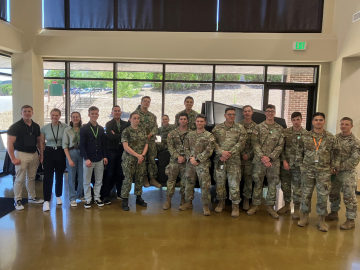
Filter News
Area of Research
- Advanced Manufacturing (2)
- Biology and Environment (14)
- Biology and Soft Matter (1)
- Clean Energy (24)
- Computational Biology (1)
- Computer Science (1)
- Electricity and Smart Grid (1)
- Fuel Cycle Science and Technology (1)
- Fusion and Fission (14)
- Fusion Energy (5)
- Isotopes (3)
- Materials (25)
- Materials for Computing (3)
- National Security (33)
- Neutron Science (35)
- Nuclear Science and Technology (8)
- Quantum information Science (4)
- Supercomputing (28)
News Type
News Topics
- (-) Chemical Sciences (27)
- (-) Cybersecurity (14)
- (-) Fusion (31)
- (-) Grid (26)
- (-) Machine Learning (22)
- (-) Microscopy (20)
- (-) National Security (45)
- (-) Neutron Science (49)
- (-) Quantum Science (31)
- (-) Space Exploration (12)
- 3-D Printing/Advanced Manufacturing (42)
- Advanced Reactors (8)
- Artificial Intelligence (50)
- Big Data (29)
- Bioenergy (51)
- Biology (60)
- Biomedical (30)
- Biotechnology (12)
- Buildings (21)
- Clean Water (15)
- Climate Change (52)
- Composites (8)
- Computer Science (87)
- Coronavirus (17)
- Critical Materials (5)
- Decarbonization (46)
- Education (1)
- Emergency (2)
- Energy Storage (30)
- Environment (105)
- Exascale Computing (28)
- Fossil Energy (4)
- Frontier (26)
- High-Performance Computing (47)
- Hydropower (5)
- Isotopes (30)
- ITER (2)
- Materials (44)
- Materials Science (47)
- Mathematics (7)
- Mercury (7)
- Microelectronics (3)
- Molten Salt (1)
- Nanotechnology (16)
- Net Zero (8)
- Nuclear Energy (56)
- Partnerships (19)
- Physics (31)
- Polymers (8)
- Quantum Computing (22)
- Renewable Energy (1)
- Security (12)
- Simulation (33)
- Software (1)
- Statistics (1)
- Summit (31)
- Sustainable Energy (48)
- Transformational Challenge Reactor (3)
- Transportation (27)
Media Contacts

Elton Aba, an intern at the Department of Energy’s Oak Ridge National Laboratory, collaborated with researchers to explore an intriguing intersection: how biology can inform cybersecurity. Aba shared some of his findings on how biomimicry could help secure our nation’s critical infrastructure.

Mohamad Zineddin, a distinguished researcher in nuclear and radiological engineering, recently received the Roger Howsley Award for Excellence in Nuclear Security.
Researchers at ORNL recently demonstrated an automated drone-inspection technology at EPB of Chattanooga that will allow utilities to more quickly and easily check remote power lines for malfunctions, catching problems before outages occur.

Researchers at ORNL are using satellite images of homes under construction to address gaps in census data, especially in areas like Sub-Saharan Africa. By analyzing these images, they estimate dwelling sizes and population densities where traditional data is sparse. This method improves population estimates and supports national security by enhancing emergency response capabilities.

A study found that beaches with manmade fortifications recover more slowly from hurricanes than natural beaches, losing more sand and vegetation. The researchers used satellite images and light detection and ranging data, or LIDAR, to measure elevation changes and vegetation coverage. Changes in elevation showed how much sand was depleted during the storm and how much sand returned throughout the following year.

At ORNL, a group of scientists used neutron scattering techniques to investigate a relatively new functional material called a Weyl semimetal. These Weyl fermions move very quickly in a material and can carry electrical charge at room temperature. Scientists think that Weyl semimetals, if used in future electronics, could allow electricity to flow more efficiently and enable more energy-efficient computers and other electronic devices.

Benjamin Manard, an analytical chemist in the Chemical Sciences Division of the Department of Energy’s Oak Ridge National Laboratory, will receive the 2024 Lester W. Strock Award from the Society of Applied Spectroscopy.

The 26th annual National School on Neutron and X-ray Scattering School concluded on August 9, 2024. Each year, more than 200 graduate students in North America studying physics, chemistry, engineering, biological matter and more compete to participate in NXS. However, given limited space, only 60 can be accepted. The school exposes graduate students to neutron and X-ray scattering techniques through lectures, experiments, and tutorials.

Ten future U.S. Army officers recently visited ORNL to learn about the legacy of nuclear science. As students of the Nuclear Science and Engineering Research Center, or NSERC, with the Defense Threat Reduction Agency, or DTRA, they stopped in East Tennessee as part of a larger tour across nuclear facilities supporting the military. In Oak Ridge, they visited ORNL to gain an appreciation of the history of the Manhattan Project and how research at a national lab contributes new materials and electronics for the nuclear industry.

Five researchers at the Department of Energy’s Oak Ridge National Laboratory recently completed an eight-week pilot commercialization coaching program as part of Safari, a program funded by DOE’s Office of Technology Transitions, or OTT, Practices to Accelerate the Commercialization of Technologies, or PACT.


